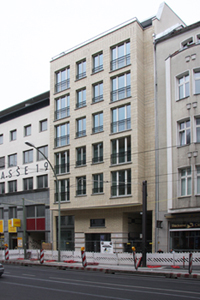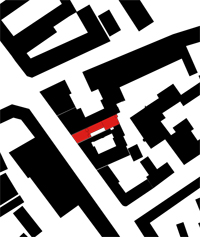You are in: Home page > Magazine > Continuing the cities tale
Continuing the cities tale
Berlin Urban Walls

Antje Freiesleben

Frontage on the Chausseestrasse
“Building the Built” is a task we architects should be grateful for: the place already exists, its identity firmly rooted in the context. It just needs to be discovered, or rather, understood. There are different approaches to this task. Either the approach of building in stark contrast or continuing a story started long ago, an insert.
Our generation knows them both and can use them with awareness.
We regard a house in the city as part of an internal continuous space.
The structure of the city is based on its urban blocks produced by the buildings according to an additive logic. The formation of the blocks corresponds in the majority of European cities to the clear-cut principle of compact construction. As meagre as the elementary concepts of town-planning may be, the variants they permit are numerous, think of Venice, Bern, London, Vienna, Berlin, Budapest, and so on. These variants derive from the different sizes of the built parcels according to topography, history, programme and site. The houses have been built on these parcels, one next to another and shape that essential element of any city’s space: the street frontage.
The vicissitudes of time created smaller and larger emptiness in the fabric, created by block, parcel, house and street frontage, in some cities less, in others more. In a city like Berlin, so strongly conditioned by history, there are many “holes” in the city layout and therefore a high potential for densification. Entire blocks are rebuilt, empty parcels filled and abandoned industrial areas reconverted.
This is the “built” within which we build. The two residential buildings we are presenting fill gaps in Berlin’s street fronts, a large parcel in a relatively small block and a long narrow parcel in a particularly deep block. Each situation demands its own response. The objective common to both interventions is how they are perceived as part of a larger unit. They do not use the context as a stage for a performance, but complete and enrich it.
Choriner Strasse leads from Torstrasse up the hill of Berlin´s glacial valley. It is a quiet residential street, formed in the second half of the 19th century and featuring great uniformity. The neo-Renaissance façades of the five-storey residential buildings have no bay windows or balconies, the walls of Choriner Strasse are flat and stern.
The parcel at number 79 has never been built on and constitutes with its width of 32m a particular case in the fabric of Berlin Mitte, whose parcels normally measure 15-18m. The problem we sought to solve with this project was the risk of the new building assuming a disproportionate weight compared to the homogeneous constructions in the context.
The residential building with its sand-coloured plaster façade displays a noble simplicity, from which emerge two bay windows that break up the long frontage. The angular cornices in natural stone constitute an elegant connection between the high side windows, the small openings of the stair wells and the generous openings in the centre of the façade.
Chausseestrasse is, unlike the Chorinerstrasse, a heavily trafficked artery that leads from the Oranienburg Gate in Mitte towards Wedding. Until around 1880, this area was home to Berlin’s heavy industries before they moved to the suburbs. The large blocks remain, with Berlin´s typical mixture of dwellings along the streets and courtyards for manufacturing and commercial activities inside. Today, Chausseestrasse has a multi faceted, heterogeneous look: houses and offices from the Wilhelminian period alternate with buildings from the GDR and new post-unification edifices gasping to show off stand next to low cost speculative housing.
The parcel at number 18, enclosed by high firewalls, is just twelve metres wide but stretches for sixty metres into the block. Despite this extreme cut, the new construction takes its cue from Berlin’s typology applying one house at the street and others parallel to it overlooking the court, onnected by narrow side wings. On the ground floor and the mezzanine are commercial and professional spaces, above, up to the 22-metre high eaves dwellings topped by a penthouse. A bay-window occupies almost the entire width of the façade and rises to meet the parapet of the mezzanine, as if the house, squeezed into the narrowness of the block, is claiming back its rightful space.
As part of the Edison courtyards, where in 1896 Emil Rathenau settled with what would later become AEG, the residential building should show a brick façade; a further exception in the already excessive heterogeneity of Chausseestrasse´s façades. However, the light yellow bricks are well adapted to the plaster and sandstone of the surrounding buildings.
The façade features the theme of wrapping and covering, with a cladding in klinker tiles, laid in the “Pruessverband” manner (see figure x), clinging to the building like bespoke clothing.
The buildings on Chorinerstrasse and on Chausseestrasse, are part of the street occupy a precise site and fill it to form a part of Berlin. They are ordinary since they are a part of everyday life with no intention to show off. At the same time they are precise and authentic and complete the context with their own stories.
Antje Freiesleben, architect at the studio Modersohn & Freiesleben in Berlin, has created numerous public and private buildings. She has collaborated with various institutes including the Universities of Berlin, Hamburg and Weimar.

.














